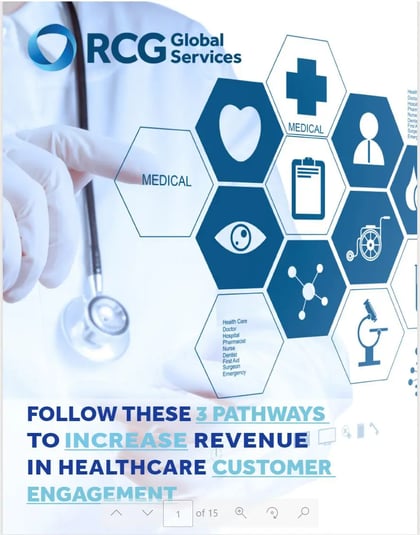3 Pathways to Increase Revenue in Healthcare Customer Engagement
The healthcare industry nearly universally accepts the need to improve customer engagement. But how do you evaluate the potential benefits and justify customer engagement investments?
The healthcare industry

Though the US healthcare system comprised 17.9% of the 2018 economy, investment in engagement remains behind. Healthcare organizations must prioritize customer engagement strategy. Are your initiatives and investments enough?
The healthcare industry nearly universally accepts the need to improve customer engagement, learning lessons from consumer-facing industries such as technology, retail, and hospitality. But how do you evaluate the potential benefits and justify customer engagement investments in programs, systems, and technologies?
Improving the consumer’s willingness and ability to engage actively in their care is an obvious good but the investment must also be evaluated on the quantifiable revenue increases it enables.
A better-engaged customer population leads to revenue gains through these three pathways:
Every system today needs to be assessing these revenue pathways and measuring and projecting quantifiable metrics tied to them.
Customer Engagement: The Primary Strategic Objective

Yet for all the size and complexity of the industry, investment in customer engagement is woefully behind other industries. When discussing patient/ customer engagement with our clients we emphasize the following:
Your system is not competing against other healthcare entities for customer engagement, your system is competing against the likes of Disney, US Bank, and Starbucks.
A 2019 survey from the New England Journal of Medicine highlights the point.
The engagement expectations of the healthcare consumer are not based on past interactions with healthcare entities; their expectations are established based on interactions with high engagement financial services and hospitality organizations. Typically, the level of interaction and available processes from your banking platform and Starbucks vastly outweigh potential interaction and engagement possibilities with your healthcare provider.
The successful, next-generation healthcare organization will have customer engagement as their primary strategic initiative. If they do not, they will either close or be consumed by competitors.
Most healthcare systems have multiple initiatives and technology investments underway to improve the “patient experience”, “engagement”, and “patient satisfaction”. Albeit highly worthwhile, such initiatives do not go far enough. A key challenge to managing these investments is evaluating the actual and potential benefits with concrete, quantifiable models and metrics. Anyone who has ever engaged in a budget cycle understands the need to substantiate and defend the financial value of technology investments. In this case, that means showing how improving customer/patient engagement leads to revenue increases.
The Patient Engagement Business Case
.png?width=1160&height=580&name=5-Ways-Stay-Ahead-Changing-Patient-Demand%20(1).png)
Increased patient engagement has proven to lead to improvements in
several key measures, including:
- Better patient health outcomes and perceived well-being are realized by improving patient compliance with prescriptions and other recommendations, increasing follow-up frequency and enhancing customers’ self-knowledge and control of their condition(s).
- Increased patient satisfaction and retention are achieved because engaged patients play an active role in their own care, so they feel part of a team, leading to more loyalty and less churn.
- Enhanced quality and safety are demonstrated by more proactive patient education and more responsive follow-up, leading to fewer self-care errors and care gaps.
- Improved financial and operations efficiency resulting from revenue increases and cost reductions which are in turn driven by more patient visits, less churn, and improved clinician and staff utilization.
Traditionally, business cases for increasing the patient engagement technology spending have focused on financial and operations efficiency, cost savings, and supporting the collection components of the revenue cycle.
A better business case focuses on the incremental revenue that patient engagement technology can enable. The business case does this by identifying revenue pathways, quantifying and measuring business metrics, and selecting tools and investments.
Revenue Pathways

RCG has identified three pathways through which engagement enhances revenue, along with several metrics that can help quantify and prove the business benefits of patient engagement technology:
1. Increased Visits
Opportunity: For a system with an average appointment fill rate of 80-95%, the first revenue pathway focuses on capturing the 5% to 15% in potential additional appointments.
Approach: This pathway uses technology-enabled appointment no-show reduction techniques coupled with dynamic waitlist & capacity management systems to fill this appointment gap, directly increasing revenue.
2. New Patient Acquisition/ Referrals
Opportunity: The revenue potential of a new patient ranges from $100 per physician visit to $2,000 per inpatient day. A thousand new patients with eight physician visits and four inpatient days each will yield an incremental $4.8 million per year in revenue.
Approach: This revenue pathway focuses on using engagement technologies to attract and enroll new patients. This necessitates using tools supporting geolocation technologies, market analysis and microtargeting, and social media management.
3. Patient Retention
Opportunity: Using the above new patient revenue estimate, the revenue opportunity cost of losing an existing customer is $4,800/year.
Approach: This revenue pathway evaluates the patient return rate and incorporates technology and analytics to identify patterns and causes of patient loss and to predict potential customer loss situations. Factors such as a patient moving out of the area and changing jobs and health plans impact this metric independently of the level of customer engagement. Such factors complicate the calculation but are still amenable to analysis with current clustering and multivariate analysis techniques.
Revenue Pathway Metrics

To baseline the current state and measure the impact of the technology investment, the business case must identify specific metrics, measure their current value before any change, and then calculate projected values after implementation.
Metrics allow for baselining current operations and estimating a range of impact from the patient engagement technology investment. Some key performance indicator metrics that support revenue-based business cases and tie to the pathways above are included in the eBook version of this article.
Patient Engagement Technologies

Systems must determine not only what fits
with the current architecture, but also what choices can be tied back to incremental revenue generation, manageable cost, and a positive business case.
Some of the engagement technologies that support the above metrics include:
- Patient applications and portals to enable a central location for patient interaction.
- Scheduling software to support online appointment scheduling, including real-time updates on provider schedule status.
- Appointment reminders to add value by being proactive and providing information like the estimated time the provider will be available as well as links to options for transportation like traffic, public transport, and weather.
- Secure messaging to allow better management of appointment wait lists along with contacts for medication and appointment follow-ups.
- Patient view, download, and transmit options to provide patients the tools and information required to make educated decisions and participate fully in their care.
- Responsive prescription refills to track patients’ refill rate for compliance and average consumption behaviors
- Online payments and billing statements to provide improved ease of use to meet patient financial obligations in an obtuse and complicated payment process and improve the usability of the healthcare system from the financial perspective.
Further, these technologies are often planned and implemented together as a program to target one of the above revenue pathways. For example, we recently supported a healthcare system that evaluated and is implementing online scheduling, multi-channel reminders for appointments (i.e., voice, email, text, mobile), and a capacity management analytics tool.
Building the Business Case

A sample process would follow these four steps:
- Baseline – Target the increased visits revenue pathway and the current visit yield metric
- Projection – Range of visit increases due to online scheduling capability (a range as this will need to be estimated based on comparable system implementations, technological maturity of current patient base, and concessions to potential multi-variant impacts [i.e., other engagement efforts that may be underway to increase visit yield])
- Revenue Increase – Calculation of the estimated incremental revenue generated from the new patient engagement technology investment
- Business Case – Estimation of costs to develop, implement, operate, and amortize the online scheduling tool and develop the business case
Note that the focus remains on the revenue increase and not the business case initially. Business cases are impacted by operational versus capital cost allocations, multiple and differing time parameters for measurement, and cost accounting allocations for development.
Drive the Top-line with a Business Case for Customer Engagement

Modern healthcare systems are actively investing in customer engagement technologies. To remain competitive and drive revenue gains, these systems are building business cases for technology investments as part of their customer engagement strategy. An effective customer engagement strategy also establishes key baseline metrics for the current state and targets expected, measurable impacts of the technology investments.
The time to start is now. Is customer engagement the primary strategic initiative and technology investment in your organization?
RCG has helped customers build compelling business cases showing quantifiable revenue improvement following each of these pathways and using each of the metrics. Call us to learn more about calculating and projecting values for the metrics and how we can help prove the value of your patient engagement technology investments.
Download a PDF version of this ebook by filling out this form


